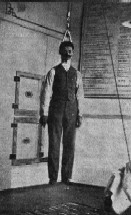Mad Science Experiments
Amazing Stories from the History of Science
Home
|
Can a remote control help in a bullfight? What if there were 28 hours in a day? Does a dog take a robot dog for real? This website is devoted to scientific experiments that tried to answer such questions. Some truly ingenious - others less so...
You can watch a lot of amusing film clips like the one below and learn about The Mad Science Book a collection of amazing experiments from the history of science.
The experiment above resulted in the formal scientific publication Social behaviour of dogs encountering AIBO, an animal-like robot in a neutral and in a feeding situation (more in the book on page 280). (For more research on robots and artificial intelligence visit Frédéric Kaplans homepage.)
Or watch Étienne-Jules Mareys famous falling cats!
In 1894, the Paris Academy of Sciences issued a general appeal for anyone to "explain how, according to the laws of physics, a cat will always manage to hit the ground paws first after falling from a great height."
The puzzle was solved by physiologist Étienne-Jules Marey who constructed a film camera that could capture the falling cat at a speed of sixty frames per second. The pictures were published in the article Mecanique animale: Des mouvements que certains animaux executent pour retomber sur leurs pieds lorsqu'ils sont precipites d'un lieu eleve (more in the book on page 46).
Marey did similar experiments with dogs and rabbits (see for yourself). More filmclips about weird experiments can be found here: |
Ranking The winner is psychologist Milton Rokeachs 1959 study "The three Christs of Ypsilanti", where Rokeach brought together three men who all thought they were Jesus and monitored what happened. [1] full story Runner-up is a Swiss study from 1955. Psychiatrists at the Friedmatt Sanatorium and Nursing Home in Basle, Switzerland, were trying to diagnose schizophrenia by looking at webs spun by spiders who were administered the urine of schizophrenics. [2] full story The third weirdest experiment was conducted by Roumanian forensic scientist Nicolas Minovici, who around 1900 instructed an assistant to hang him and some of his collaborators 12 times in order to find out what happens when somebody is hanged. [3] full story For more information and high resolution pictures please contact . The Ranking 1. The three Christs of Ypsilanti -Three men think they are Jesus. What happens when they meet?(1959) 17% votes full story 2. Diagnosing schizophrenics with spider webs (1955) 15% votes full story 3. The hanging studies (1905) 4. Brilliantly saying nothing. Does anyone notice? (1970) 12% votes full story 5. Staying in bed for one year (1986) 10% votes full story 6. Crucifiying volunteers (1984) 10% votes more [1] Rokeach, M. (1964), The Three Christs of Ypsilanti. Alfred A. Knopf.
"Do embarrassement researchers ask you to suck a pacifier in public?" "Did Darwin play the bassoon for worms?" Know the answers? Then you are ready for the mad experiments quiz.
|
|
